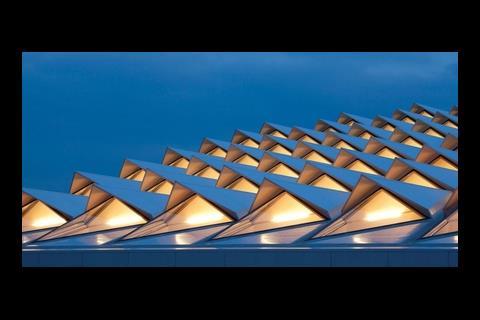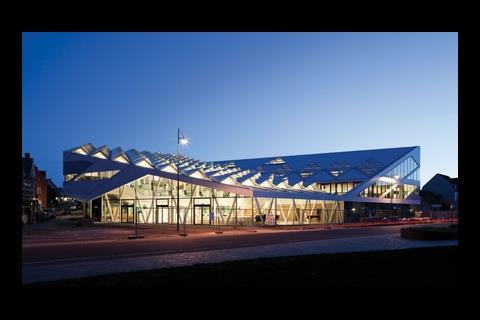3XN’s bold and dynamic savings bank in Denmark offers unbeatable interest. Ike Ijeh opens an account
The 2006 Mipim Future Project Award was won by a bank in the small peninsula town of Middelfart in central Denmark. As the building nears completion, Middelfart Savings Bank’s bold and distinctive contribution to the local urban landscape is becoming apparent. As is the generous provision it makes for public realm, both externally and internally. Less visible, however, is its pioneering use of green technologies to create a building that not only achieves energy efficiency but significant cost savings.
Designed by Danish RIBA International Award winner 3XN Architects, the 5,000m2 building uses the bank as an anchor around which a square, cafe and shops are grouped. The entire complex is then covered by a large sloping roof punctuated with strategically positioned openings. These openings are all aligned to give views of the sea from virtually all parts of the building. The large wooden roof, with its distinctive latticework grid of triangular openings, acts as a unifying element internally and makes a dynamic impact externally.

The building makes further gestures to its surroundings. Its footprint retracts towards the adjacent harbour, creating a triangular plaza that opens up the view towards the sea and in which the main entrance is located. On the opposite side of the bank, towards the town, the scale of the building is adjusted to relate to the character and dimensions of the existing fabric.
Internally, the main indoor square is made up of a series of interconnected terraces that afford access to the outside plaza as well as internal office spaces. The terraces are linked by broad internal staircases envisaged as informal meeting places.

The building also harnesses a series of sustainable innovations. It is heated and cooled using plastic pipes embedded within the prefabricated concrete decks of the building’s floor. In the winter, heat pumps provide a low-temperature floor heating system while during the summer, cool night air, ground source or sea water can be used for cooling. The system is partially self-regulating, as water for heating and cooling is circulated at a temperature that varies by only a few degrees from the desired room temperature. The mass of the concrete also helps keep the temperature steady.
These advanced technological solutions have led to a reduction of the building’s energy consumption for heating by 30% and for cooling by almost 85%, leading to total energy reduction of as much as 30-50%. Those are the kind of savings that could start giving banks a good name …



























No comments yet